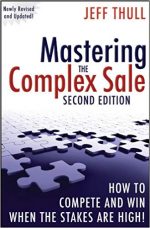Every 30 minutes a new business book is published; many of them purport to teach effective selling. Most of them make sense, but solid quantitative analysis is rarely on the front burner. This is strange, because effective selling requires demonstrating value. Sales professionals are taught to show components of value such as cost savings or improved lead generation, but, in most sales with price tags sufficient to warrant the involvement of a sales professional, the total value is a more complex proposition.
Dave Bridgeland, a data science consultant in the Washington, D.C. area, has come up with what he calls the “value clarity model” simulation model to deal with the sales process that lies behind a complex sale.
Simulation has a storied history in operations research as a tool to understand the range of possible outcomes in situations with many interconnected moving parts. A classic example is the decision to bid on an oil lease. The value of the lease depends on a number of variables, such as:
- the probability distribution of different quantities of oil being found
- the probabilities of different production cost structures being encountered
- the temporal probability of different future oil prices
- different possible actual and opportunity costs of exploration
In a simulation, you repeatedly generate random values for the various uncertain quantities and, for each run through the simulation, record the net result. After many such runs, you have a distribution of the range of possible results and their likelihoods.
As complex as an oil lease simulation may be, it is reasonable well-defined and transferable from one situation to another, and simple in comparison to the task of simulating the complex sales process.
Bridgeland builds simulations so that sellers of complex big-ticket items can see the range of possible outcomes in the sales scenario, and the ramifications of different decision options from the buyer’s perspective. Most important, the simulations provide a structure to break down a complex scenario into components that can be quantified, and probabilities attached to different outcomes. This development of “profound knowledge” of the sales scenario benefits both the buyer, who ultimately gains the tools to increase profit, and the seller, who gains a competitive advantage over vendors who lack the ability to impart “profound knowledge.”
For example, airlines purchase jet aircraft and typically make separate purchase decisions for engines; there are only a handful of engine manufacturers. The decision is complex:
There are several non-cost performance goals: cruising speed, static thrust, thrust to airspeed ratio. Increasingly, carbon emissions are also viewed as a performance goal.
Likewise, there are multiple cost factors: initial cost, maintenance, fuel consumption (taxi and cruise). The latter two depend on factors like typical stage length, payloads, and intensity of use.
A traditional sales pitch would stress the strong points of a particular vendor’s product. A “value clarity” simulation model will take all factors into account to produce a range of likely outcomes. In the airline case, input variables might include a customer’s typical stage length for the aircraft in question, typical customer loads, frequency of use, fuel cost at the company’s served airports, taxi time at busy airports, maintenance costs, and more. The main quantity to be optimized would probably be cost per mile flown, or something similar. There are multiple complexities to be factored into the simulation – e.g. the airline might have offshore maintenance bases that save maintenance costs, but those savings would need to be offset by the increased time out of service. The airline may schedule aircraft tightly, which can produce more delays that require aircraft to be flown at faster, less efficient speeds.
The ability of a seller to provide a simulation structure that walks a purchaser through these various elements and helps them clarify and make uncertainties explicit can be a valuable selling tool, because it helps the buyer make an informed decision and increases confidence in the vendor.
Jeff Thull’s